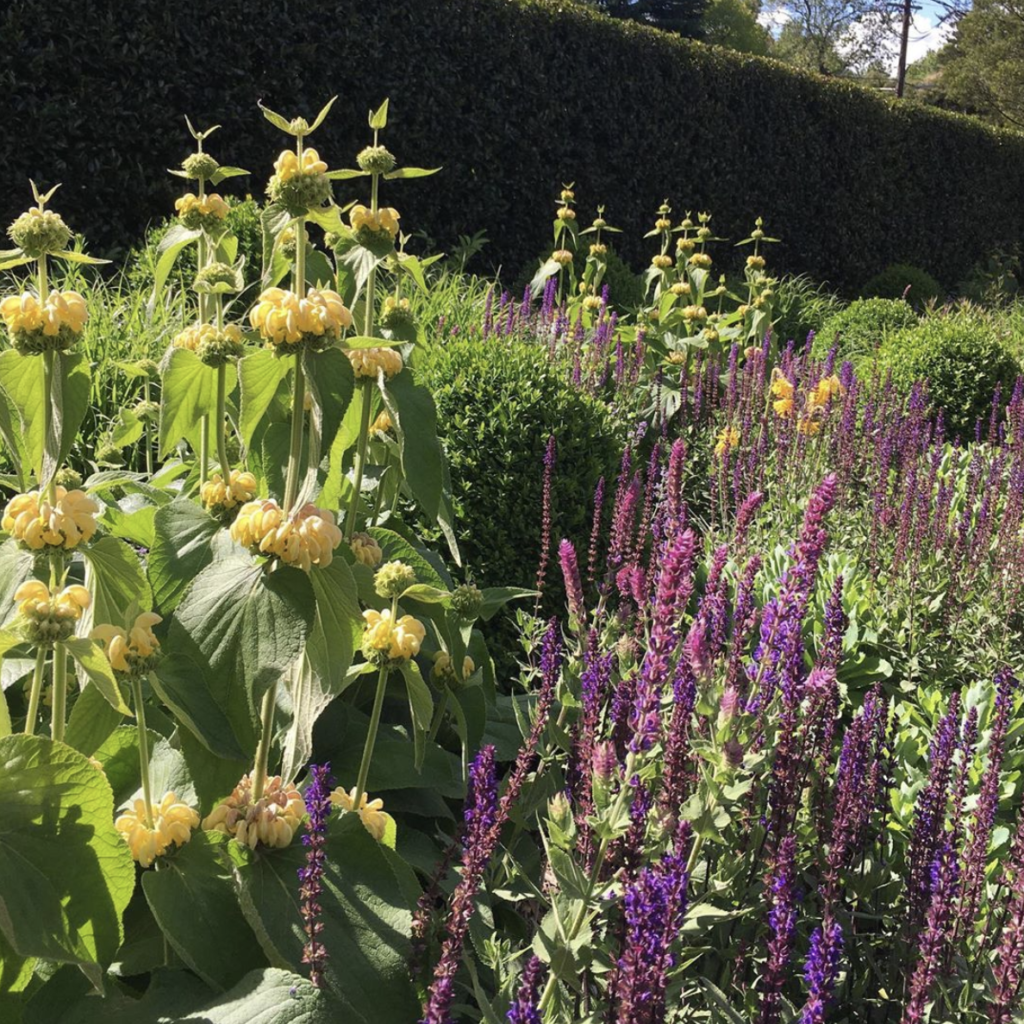I’ve always been someone who arrives late to a party and I’m rather embarrassed to admit that I’ve only recently discovered how much fun Phlomis russeliana can be, which leaves me wishing I’d arrived at this particular party a lot earlier.
Otherwise known as Turkish Sage, Phlomis russeliana is a member of the mint family and is native to Turkey and Syria, where I have been told you can see it growing wild along roadsides. It forms thick evergreen mounds to around 30 cm high of handsome elongated heart-shaped leaves. The velvety foliage is a beautiful matt green with a greyish underside making it work very well under the Australian light and enabling it to happily blend within a more Mediterranean palette. Foliage and form: massive tick.

The party gets going in spring when it begins to send up sturdy stems to around 100cm high that by late spring have unfurled beautiful whorls of soft yellow flowers at intervals along its length. For some reason they remind me of Lando Calrissian’s cloud city in ‘The Empire Strikes Back’. They have a beautiful floating quality creating an airy mood, and it’s a delight to watch the bees hover in and out. I love how they give my perennial garden some good early season height, well before the Miscanthus and tall prairie plants have even left the blocks. Flower and mood: tick, tick.

As the party moves toward the end of summer, the flowers fade and the stems and flower heads brown off. Now I’m sure we all freely admit that none of us are perfect and I’m sorry to say that neither is Phlomis russeliana. I find this part of the season the only disappointment as unlike some earlier flowering perennials such as Salvia nemorosa, deadheading to encourage a second flush doesn’t work. So in a perennial-heavy planting, you are left with the situation of your early flowering perennials looking refreshed with their second (or third) flowering, and you have your late season perennials like your asters, sedums, Sanguisorba and Miscanthus reaching their peak. The next step is up to you. You can dead head the Phlomis and be left with just the fresh foliage and a fresh looking perennial-party for beautiful people only or… you can leave it be and be rewarded down the track. My advice is to leave it be (Disclaimer: For some reason I’ve never been allowed entry to a party for just beautiful people so I really wouldn’t know what that’s like).
So, now we get to the really good bit, which is when the autumn decay of other perennials kicks in and we head into winter, the flowering stems of Phlomis russeliana are a dramatic deep chocolate brown, turning almost black when wet with mist and rain. The sturdy stems are impervious to the strongest wind and remain all winter long. The strong shape and colour bounce superbly off a background of bleached swaying Miscanthus, the dark brown flower heads continuing to lend an airiness but this time with added drama and contrast. For me the favourite time of the year is when autumn tips into winter, and I think this is where Phlomis russeliana becomes the life of the party, keeping it going well into the night.

And even though it may be a little while off yet, aren’t we all looking forward to a good long party! 😊
Follow Ashley on istagram – sassafras_gardens
Lovely to read about Rousselliana. Can you help me with the pruning routine for other Phlomis with smaller more silver leaves??
of the shrubby sort?
Hi Jill. I think with many Phlomis, the pruning regime allows you to exercise your own personal preference in that you can dead head the spent flower stalks and allow the shrub to do it’s thing and bulk or you can trim it back and treat it as you would an herbaceous perennial. Either way this Phlomis provides beautiful foliage the year round. I personally treat it a little as if it were an herbaceous perennial and give it a good hair cut at the end of August. When I do this, I find that I reveal lots of lovely fresh basal growth and it reinvigorates the plant. This then blends it in with its herbaceous perennial neighbours and by now all I am enjoying is fresh new season growth. I hope this helps!
Ash, I always thought this to be a full sun, dry loving plant, but so often see the foliage burning here in Australia when in that kind of setting. I remember seeing it in quite cool, shady locations in an English garden, and the foliage was much larger, and lusher – as you’d expect – and I saw it with new eyes. Have you ever tried growing it somewhere shadyish, or cool?
Hi Michael. I’ve found that the foliage does tend to wilt during a very hot afternoon however they always bounce back in the evening. In extreme dry I’ve noticed that the leaves can yellow somewhat but overall it is an extremely resilient plant that is very much able to bunker down during hot dry spells. I have it dotted throughout my own perennial border (in Sassafras) of which one end is lucky to receive 3 hours of direct sun per day and it performs exactly the same. So yes, I would definitely say that it is happy in part (to considerable) shade. You could put it in the same class as many Euphorbias in that regard in that they are surprisingly capable of performing just as well in part shade as they are in full sun.